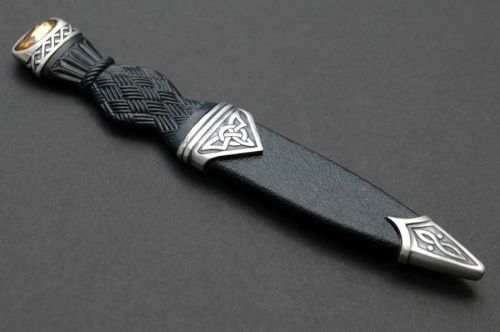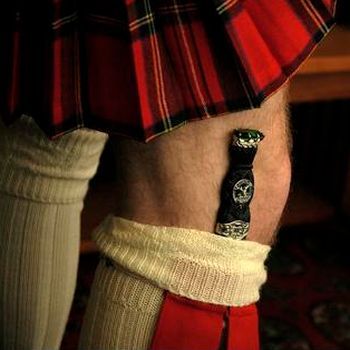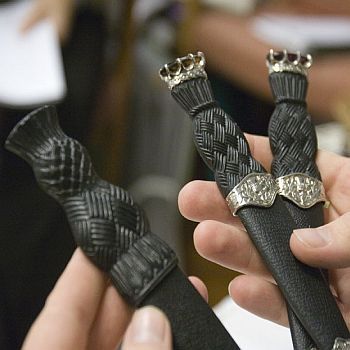art-of-swords:The Sgian-dubh KnifeThe sgian-dubh is a small, single-edged knife (Gaelic sgian) worn
art-of-swords:The Sgian-dubh KnifeThe sgian-dubh is a small, single-edged knife (Gaelic sgian) worn as part of traditional Scottish Highland dress along with the kilt. Originally used for eating and preparing fruit, meat, and cutting bread and cheese - as well as serving for other more general day to day uses such as cutting material and protection, it is now worn as part of traditional Scottish dress tucked into the top of the kilt hose with only the upper portion of the hilt visible. The sgian-dubh is normally worn on the right leg, but can also be worn on the left, depending on whether the wearer is right or left-handed.The name comes from the Gaelic “sgian-dubh”. Although the primary meaning of dubh is “black”, the secondary meaning of “hidden” is at the root of sgian-dubh, based on the stories and theories surrounding the knife’s origin, in particular those associated with the Highland custom of depositing weapons at the entrance to a house prior to entering as a guest.Compare also other Gaelic word-formations such as dubh-sgeir “underwater skerry” (lit. black skerry), dubh-fhacal “riddle” (lit. hidden word), dubh-cheist “enigma” (lit. hidden question). Despite this practice, a small twin edged-dagger, (a mattucashlass, Gaelic sgian-achlais), concealed under the armpit, combined with a smaller knife, (‘sgian-dubh’), concealed in the hose or boot, would offer an element of defence or of surprise if employed in attack.As sgian is feminine, we would expect the form sgian dhubh, since a feminine noun causes initial consonant lenition in a following adjective, and indeed the every-day modern Gaelic for a normal ‘black knife’ is sgian dhubh. However, the term for the ceremonial knife is a set-phrase containing a fossilized historical form. In older Gaelic, a system of blocked lenition meant that lenition did not occur when the adjective started with a consonant of the same group as the final consonant of the noun, and n and d are both alveolar.Various alternative spellings are found in English, including “skene-dhu” and “skean-dhu”. The plural is most commonly sgian-dubhs (in its various spellings) but sgians-dubh is also occasionally encountered. The proper Gaelic plural forms sg(e)inean-dubh or sgianan-dubh are only rarely encountered in English usage.In terms of construction, the early blades varied, some having a “clipped” (famously found on the Bowie knife) or “drop” point. The “spear-point” tip has now become universal. Scalloped filework on the back of the blade is common on all Scottish knives. A short blade of 3 to 3.5 inches (76 to 89 mm) is typical.Since the modern sgian-dubh is worn mainly as a ceremonial item of dress and is usually not employed for cutting food or self-defence, blades are often of a simple (but not unglamorous) construction. These are typically made from stainless steel. The hilts used on many modern sgian-dubhs are made of plastic that has been molded to resemble carved wood and fitted with cast metal mounts and synthetic decorative stones. Some are not even knives at all, but a plastic handle and sheath cast as one piece.Other examples are luxurious and expensive art pieces, with hand-carved ebony or bog wood hilts, sterling silver fittings and may have pommels set with genuine cairngorm stones. Blades may be made of Damascus steel or etched with Celtic designs or heraldic motifs. The earliest known blades some of which are housed in the National Museum of Scotland in Edinburgh are made from German or Scandinavian steel which was highly prized by the Highlanders.Traditionally the scabbard is made of leather reinforced with wood and fitted with mounts of silver or some other metal which may be cast or engraved with designs ranging from Scottish thistles, Celtic knotwork, or heraldic elements such as a crest. While this makes for more popular and expensive knives, the sheath is hidden from view in the stocking while the sgian-dubh is worn. The sheaths of many modern sgian-dubhs are made of plastic mounted with less expensive metal fittings.Sources: Copyright © 2014 Wikipedia | Oregon Knife Club | Scotland for Visitors -- source link
#weapons



